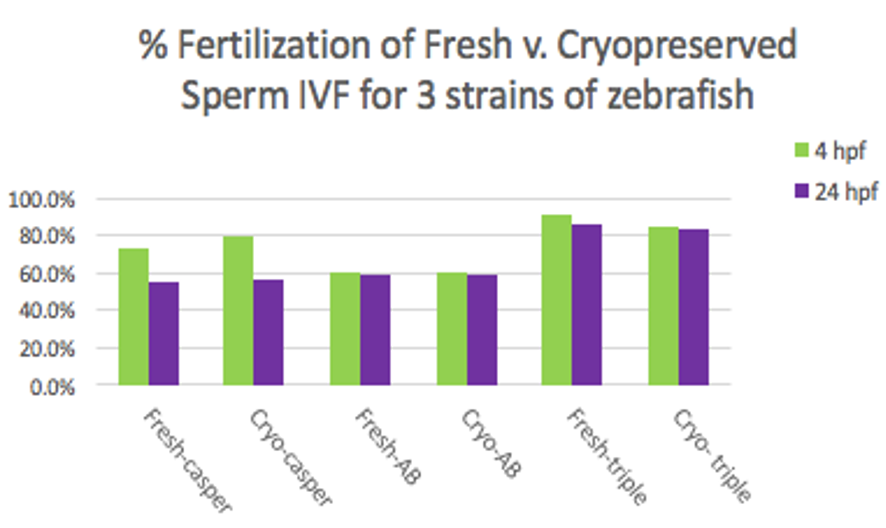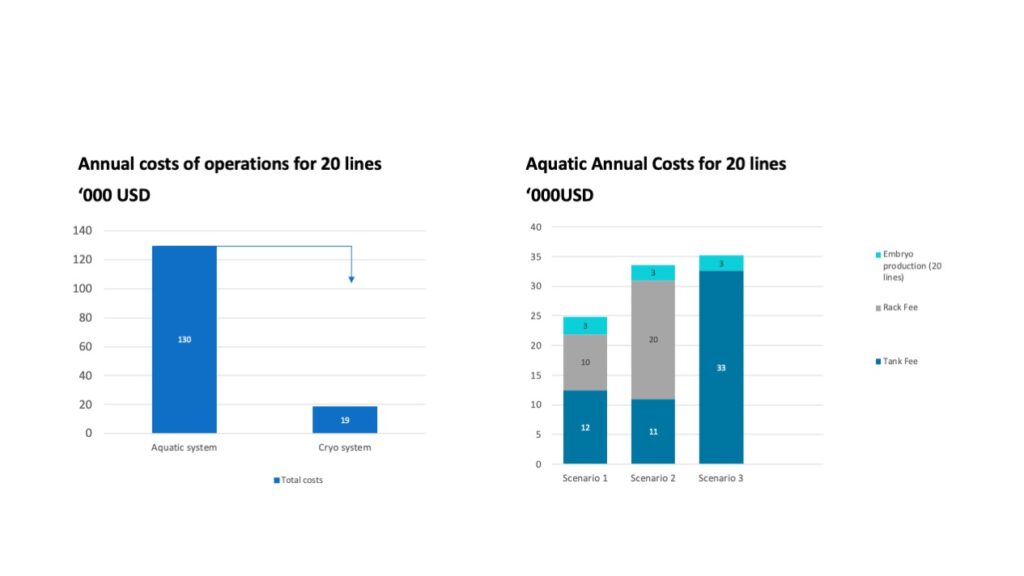Throughout the last ten years, usage of zebrafish as a model organism has increased significantly. With over 20 000 mutant, transgenic and wild type variants, zebrafish has become #3 animal model in the US and #2 animal model in Europe and Canada. However, there is still a potential to improve line maintenance and reproduction process through applying cryopreservation.
Today, cryopreservation is used as a unique tool allowing scientists to create a reliable back-up of their valuable lines. Our aim is to introduce a standardised cryopreservation program, creating better animal welfare in your lab, by rotating the lines and having only healthy fish in your system.
Line maintenance
Maintaining a breeding colony of zebrafish is one method of generating and ensuring an available supply of experimental subjects with desired genetic makeup. Although zebrafish breed readily every day, it is beneficial to have a frozen copy of the working line for line maintenance and as part of your research strategy.
Genetic drift is a common phenomenon which occur by chance. Specific mutations can drift away by continuous breeding of lines. We recommend to freeze the lines early to avoid genetic drift and preserve desired mutations, thus resulting in decreased workload towards line maintenance.
Reliability
Cryogenetics has for many years been improving their process of cryopreservation and IVF to create a standardised procedure. This gives reliable post-thawing survival rate of the milt and consistent IVF results at the same level as fresh milt fertilisation.

hpf = hours post fertilisation
comparing fertilisation rate using fresh vs. cryopreserved milt in three different strains
(i.e. Casper, AB and Triple)
Optimal Line Maintenance

We recommend cryopreserving every 2 – 3 generation of a line in order to achieve an optimal process to standardise line maintenance. This will make sure you will maintain strain variation and fecundity.
Cost
Compared to standard aquatic system, operational cost of implementing cryopreservation in your process is significantly lower. Introducing cryopreservation will automatically result in lower space usage, reduced labour cost and consumables, such as feed and water.
Each line is cryopreserved in our uniquely designed straws. Once cryopreserved, the labelled straws are placed vertically inside a coloured goblet which is then safely stored in a liquid nitrogen storage tank.
One straw has the capacity to fertilise a clutch of eggs obtained from one female (i.e. 300 eggs). With our standardised IVF procedures, fertilisation rates of >70% can be achieved. Allowing you to effortlessly re-establish valuable lines.
One standard 47 litre dewar can hold up to 2000 straws, giving you a life-long back-up of lines. This makes cryopreservation a low-cost and high-capacity method compared to standard aquatic systems.

Every lab is designed differently, both regarding what system they use or how it is run. The left graph is based on yearly equipment maintenance costs, electricity, water, consumables, fish feed, labour cost and space rental. Whereas the graph to the right compares cost of a full cryopreservation program, including shipments, cryopreservation work (i.e. based on 20 lines x 10 straws), storage fee, thawing and embryo production. This includes 3 scenarios, since the scale of cryopreservation depends on the size of your facility. This means that some facilities are charged by the rack and others by the tank (i.e. how many straws you have cryopreserved).
Animal Welfare
Zebrafish kept inside an aquatic system require continuous supervision. Older fish carry a greater risk to spread diseases throughout the system. By cryopreserving zebrafish lines, the chance of spreading disease is significantly reduced, which also creates more space for healthy fish. Common diseases found in zebrafish are: Pseudolma neurophilia, Pseudocapillaria tomentosa, and mycobacteriosis caused by Mycobacterium chelonae, m. marinum, and M. haempphilum.
Crisis and disaster planning
Unforeseen disasters can happen. Even a top-level aquatic system has its flaws when it comes to natural disasters or system failures. We highly recommend split-storage of cryopreserved lines to make sure that valuable genetic material is safe at all times.
For example, during the COVID-19 pandemic, many facilities had to reduce their number of fish by 25% due to staff shortage. Minor disasters such as water quality changes, or major disasters such as earthquakes are also examples of events that could terminate valuable lines in your facility.
